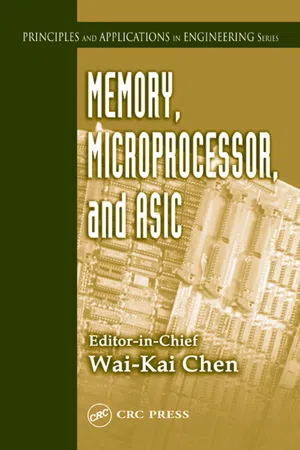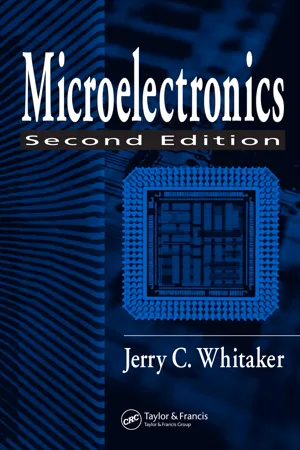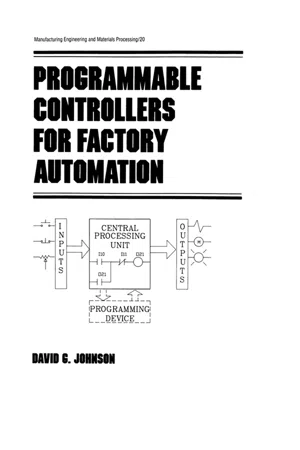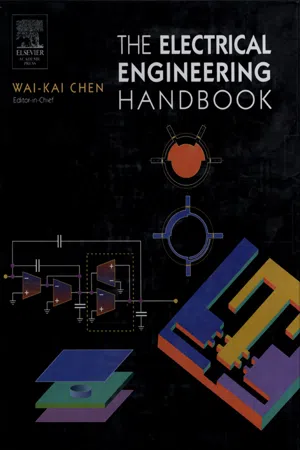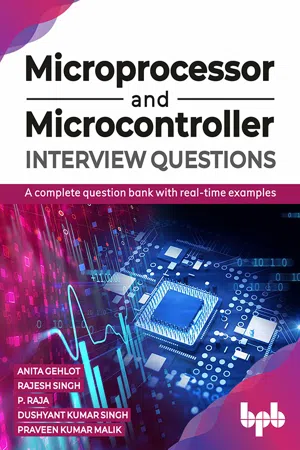Processor Architecture
Processor architecture refers to the design and organization of a computer's central processing unit (CPU). It encompasses the instruction set, data types, registers, memory access methods, and overall structure of the CPU. Different processor architectures, such as x86, ARM, and RISC-V, have distinct features and capabilities that impact the performance and compatibility of computer systems.
5 Key excerpts on "Processor Architecture"
- eBook - ePub
- Wai-Kai Chen, Wai-Kai Chen(Authors)
- 2003(Publication Date)
- CRC Press(Publisher)
...11 Architecture Daniel A.Connors University of Illinois at Urbana- Champaign Wen-mei W.Hwu University of Illinois at Urbana- Champaign 11.1 Introduction 11.2 Types of Microprocessors 11.3 Major Components of a Microprocessor Central Processor • Memory Subsystem • System Interconnection 11.4 Instruction Set Architecture 11.5 Instruction-Level Parallelism Dynamic Instruction Execution • Predicated Execution • Speculative Execution 11.6 Industry Trends Computer Microprocessor Trends Embedded • Microprocessor Trends Microprocessor Market Trends 11.1 Introduction The microprocessor industry is divided into the computer and embedded sectors. Both computer and embedded microprocessors share aspects of computer design, instruction set architecture, organization, and hardware. The term “computer architecture” is used to describe these fundamental aspects and, more directly, refers to the hardware components in a computer system and the flow of data and control information among them. In this chapter, various types of microprocessors will be described, fundamental architecture mechanisms relevant in the operation of all microprocessors will be presented, and microprocessor industry trends discussed. 11.2 Types of Microprocessors Computer microprocessors are designed for use as the central processing units (CPU) of computer systems such as personal computers, workstations, servers, and supercomputers. Although microprocessors started as humble programmable controllers in the early 1970s, virtually all computer systems built in the 1990s use microprocessors as their central processing units. The dominating architecture in the computer microprocessor domain today is the Intel 32-bit architecture, also known as IA-32 or X86...
- eBook - ePub
- Jerry C. Whitaker(Author)
- 2018(Publication Date)
- CRC Press(Publisher)
...16 Fundamental Computer Architecture Joy S. Shetler 16.1 Introduction 16.2 Defining a Computer Architecture 16.3 Single Processor Systems 16.4 Multiple Processor Systems 16.5 Memory Hierarchy 16.6 Implementation Considerations Packaging Considerations • Technology Considerations • Wafer Scale Integration (WSI) • Multichip Modules (MCMs) 16.1 Introduction The design space for computer architectures is fairly diverse and complicated. Each new architecture strives to fulfill a different set of goals and to carve out a niche in the computer world. A system can be composed of one or several processors. Many concepts apply to both multiple processor and single processor systems. Many researchers have concluded that further advances in computational speed and throughput will come from parallelism rather than relying heavily on technological innovation, as has occurred in the past. But implementation is still an important consideration for any computer system. 16.2 Defining a Computer Architecture Some important attributes of a computer system are as follows: • Structure of the control path(s) • Structure of the data path(s) • The memory organization • The technology used in the implementation • The number of clocks, that is, single clocked or dual clocked • The clock speed(s) • The degree of pipelining of the units • The basic topology of the system • The degree of parallelism within the control, data paths, and interconnection networks FIGURE 16.1 Block diagram of a single processor system. In some cases, the algorithms used to execute an instruction are important as in the case of data flow architectures or systolic arrays. Some of these attributes are dependent on the other attributes and can change depending on the implementation of a system. For example, the relative clock speed may be dependent on the technology and the degree of pipelining...
- eBook - ePub
- David Johnson(Author)
- 2020(Publication Date)
- CRC Press(Publisher)
...4 The Central Processing Unit Although referred to as the brain of the system, the Central Processing Unit in a normal installation is the unsung hero, buried in a control cabinet, all but forgotten. 4.1 BASIC FUNCTIONALITY In a programmable controller system, the central processing unit (CPU) provides both the heart and the brain required for successful and timely control execution. It rapidly and efficiently scans all of the system inputs, examines and solves the application logic, and updates all of the system outputs. In addition, it also gives itself a checkup each scan to ensure that its structure is still intact. In this chapter we will examine the central processing unit as it relates to the entire system. Included will be the various functional blocks in the CPU, typical scan techniques, I/O interface and memory uses, power supplies, and system diagnostics. 4.2 TYPICAL FUNCTION BLOCK INTERACTIONS In practice, the central processing unit can vary in its architecture, but consists of the basic building block structure illustrated in Figure 4.1. The processor section consists of one or more microprocessors and their associated circuitry. While it is true that some of the older generation programmable controllers were designed without the luxury of using microprocessors, most modern systems use either a single microprocessor such as the 8086 or Z-80, or multiple microprocessors such as the AMD2903, used in a bit slice architecture. This multi-tasking approach is used in the multiple microprocessor system to break the control system tasks into many small components which can be executed in parallel. The result of this approach is to achieve execution speeds that are orders of magnitude faster than their single-tasking counterparts...
- eBook - ePub
- Wai Kai Chen(Author)
- 2004(Publication Date)
- Academic Press(Publisher)
...The power of computation can be maximized via a systematic and seamless integration of hardware cores, operating systems, and application softwares. Throughout the 70s, microprogramming computer architecture design was the most dominant approach, and it had a fundamental influence on early development of computing systems. In general, the hierarchy of systems using microprogramming is divided into application softwares, operating systems, machine language, microprogramming, and physical devices. Since the early 80s, the ever-increasing processing power offered by VLSI technology (as governed by the Moore’s law) has fundamentally changed the computer design concept. The popularity of reduced instruction set computing (RISC) has virtually eliminated the need for microprogramming. More generally, computer architectures have undergone a rapid change driven by the VLSI, deep-submicron, and nanoscale device technologies. Chapter 2 is “Multiprocessors,” by Peter Y. K. Cheung, G. A. Constantinides, and Wayne Luk. Multiprocessors are categorized by Flynn into SISD (single instruction single data), SIMD (single instruction multiple data), MISD (multiple instruction single data), and MIMD (multiple instruction multiple data) machines. The chapter addresses fundamental issues such as how multiple processors share data, how cache memories on different processors maintain their data correctly, and how multiple processors coordinate with each other. In addition, the following two performance goals of multiprocessor system are explored: (l) increased throughput for independent tasks distributed among a number of processors, and (2) faster execution of a single task on multiple processors. The organization and programming language for the multiprocessor systems vary significantly, depending on the goal. Chapter 3, “Configurable Computing,” by Wayne Luk, Peter Y. K...
- eBook - ePub
Microprocessor and Microcontroller Interview Questions:: A complete question bank with real-time examples
A complete question bank with real-time examples
- Anita Gehlot(Author)
- 2020(Publication Date)
- BPB Publications(Publisher)
...C HAPTER 3 Microprocessor 8085 Basic terms Hardware: The interconnection of physical equipment to build or design a computer, like Input/Output devices, motherboard, memory, and accessories. Software: A set of instructions, data, or programs used to operate computers and execute specific tasks. Firmware: A software program or set of instructions programmed on a hardware device. It provides the necessary instructions for how the device communicates with the other computer hardware. Middleware: A software that acts as a bridge between an operating system or database and applications, especially on a network. Microcomputer: The term microcomputer is generally a synonymous with personal computer, or a computer that depends on a microprocessor. Microprocessor: A silicon chip that contains a CPU. In the world of personal computers, the terms microprocessor and CPU are used interchangeably. Central Processing Unit (CPU): The “brain” of a computer. Memory (RAM/ROM): A digital circuitry used to store programs and data. Bus: A multi-bit communication channel used within a computer system. Bit: It consists of 0 and 1. Nibble: Combination of 4 bits. Byte: Combination of 2 nibbles or 8 bits. Word: Combination of 2 bytes or 16 bits. Double word: Combination of 4 bytes or 32 bits. Address bus: A group wires that carries addresses of memory or I/O devices. Data bus: A group of wires that carries data from Microprocessor to memory or I/O devices and vice versa. Control bus: A group of wires that carries various control signal from Microprocessor to memory or I/O devices and vice versa. Operations (op codes): The set of basic operations that a computer can be instructed to perform, encoded in binary. Operand: The data operated on by an operation. Instruction: Combination of an op code and its operand. Program: A group of instructions that allows a computer to perform a specific job. Pin diagram and architecture of 8085 Microprocessor Pin diagram of...
